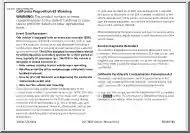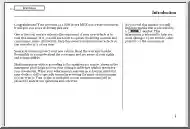No comments yet. You can be the first!
What did others read after this?
Content extract
Source: http://www.doksinet Management of Stable Angina Pectoris Istvan Edes Department of Cardiology, University of Debrecen, Hungary Source: http://www.doksinet Source: http://www.doksinet Definition and epidemiology Source: http://www.doksinet Definition of Stable Angina Clinical syndrome characterized by dyscomfort in the chest, jaw, shoulder, back or arms - Elicited by exertion and/or emmotional stress - Releived by rest and/or NTG Source: http://www.doksinet Angina pectoris Source: http://www.doksinet Epidemiology of stable angina Women: 0,1- 1 % 10-15%% aged 45-54 aged 65-74 2-5% 10-20% aged 45-54 aged 65-74 Men: Prevalence: ~20 000-40 000 per million ESC Guideline 2006 Source: http://www.doksinet Initial evaluation Source: http://www.doksinet Clinical classification of chest pain Source: http://www.doksinet Classification of angina severity (CCS) Source: http://www.doksinet Algorithm for initial evaluation of patients with angina I. Source:
http://www.doksinet Algorithm for initial evaluation of patients with angina II. Source: http://www.doksinet Risk stratification Source: http://www.doksinet Risk assesment 1) Risk stratification by clinical evaluation (diabetes, hypertension, smoking, cholesterol, metabolic syndrome, age, prior MI, symptoms of HF, pattern/severity of angina [weighted score], resting ECG abnormalities etc.) 2) Risk stratification by response to stress test (exercise capacity, induced ischemia, treadmill score, double product, induced wall motion abnormalities, large perfusion defects etc.) 3) Risk stratification by ventricular function (strongest predictor, EF<35% mortality rate >3% per year, ventricular dimensions, hypertrophy, diastolic function etc.) 4) Risk stratification by coronary anatomy (left main, one- two- or three-vessel disease, proximal LAD, disease etc.) ESC Guideline 2006 Source: http://www.doksinet Treatment Source: http://www.doksinet Aims of treatment � Improve
prognosis (prevention of MI and death stabilize plaque, prevent thrombosis) � Minimize/abolish symptoms (improve quality of life) ESC Guideline 2006 Source: http://www.doksinet Treatment of stable angina pectoris Prevention: treatment of risk factors: (lipids, diabetes, blood pressure) General management (life style changes): diet smoking traininig Pharmacotherapy to improve prognosis: Aspirin Clopidogrel Beta-blockers ACE inhibitors Statins Ca-channel blockers Treatment of symptoms Nitrates Beta-blockers Ca-channel blockers Other agents (nicorandil, ivabradine trimetazidine, ranolazine, molsidomine) Revascularization PCI, CABG Source: http://www.doksinet Short-term relief Treatment algorithm Aspirin 75-150 mg od Improving prognosis Stable angina Short-acting nitrates Contraindication Statin Dose titration to reach target cholesterol Intolerance, contraindication Interchange statins or add ezetimibe, or alternative lipidlowering agent ACE-inhibitor (in proven CAD)
Beta-blocker post-MI Beta-blocker no prior MI Symptom relief Clopidogrel 75 mg od Intolerant or contraindication Symptoms not controlled Intolerant Add calcium antagonists or long-acting nitrates Symptoms not controlled Consider revascularization Calcium antagonists or longacting nitrates or If inhibitor (ivabradin) Alternative subclass of calcium antagonists or long-acting nitrates Symptoms not controlled Combination of nitrates and calcium antagonists or K channel opener Symtoms not controlled Source: http://www.doksinet Short-term relief New treatment algorithm Aspirin 75-150 mg od Improving prognosis Stable angina Short-acting nitrates Contraindication Clopidogrel 75 mg od Statin Dose titration to reach target cholesterol Interchange statins or add ezetimibe, or alternative lipidlowering agent Intolerance, contraindication ACE-inhibitor (in proven CAD) If inhibitor (ivabradin) Beta-blocker post-MI Beta-blocker no prior MI Symptom relief Intolerant or
contraindication Symptoms not controlled Intolerant Add calcium antagonists or long-acting nitrates Symptoms not controlled Consider revascularization Calcium antagonists or longacting nitrates or If inhibitor (ivabradin) Alternative subclass of calcium antagonists or long-acting nitrates Symptoms not controlled Combination of nitrates and calcium antagonists or K channel opener Symtoms not controlled Source: http://www.doksinet Recommendation for coronary angiography ESC Guideline 2006 Source: http://www.doksinet Source: http://www.doksinet Source: http://www.doksinet Source: http://www.doksinet Source: http://www.doksinet Investigations used in the diagnosis of angina Source: http://www.doksinet Recommendations for routine investigations in angina III. Test Recommendation for diagnosis ESC Guideline 2006 Source: http://www.doksinet Recommendations for routine investigations in angina I. Source: http://www.doksinet Recommendations for routine
investigations in angina II. Test Recommendation for diagnosis Source: http://www.doksinet CV events in clinical trials of stable angina or CAD
http://www.doksinet Algorithm for initial evaluation of patients with angina II. Source: http://www.doksinet Risk stratification Source: http://www.doksinet Risk assesment 1) Risk stratification by clinical evaluation (diabetes, hypertension, smoking, cholesterol, metabolic syndrome, age, prior MI, symptoms of HF, pattern/severity of angina [weighted score], resting ECG abnormalities etc.) 2) Risk stratification by response to stress test (exercise capacity, induced ischemia, treadmill score, double product, induced wall motion abnormalities, large perfusion defects etc.) 3) Risk stratification by ventricular function (strongest predictor, EF<35% mortality rate >3% per year, ventricular dimensions, hypertrophy, diastolic function etc.) 4) Risk stratification by coronary anatomy (left main, one- two- or three-vessel disease, proximal LAD, disease etc.) ESC Guideline 2006 Source: http://www.doksinet Treatment Source: http://www.doksinet Aims of treatment � Improve
prognosis (prevention of MI and death stabilize plaque, prevent thrombosis) � Minimize/abolish symptoms (improve quality of life) ESC Guideline 2006 Source: http://www.doksinet Treatment of stable angina pectoris Prevention: treatment of risk factors: (lipids, diabetes, blood pressure) General management (life style changes): diet smoking traininig Pharmacotherapy to improve prognosis: Aspirin Clopidogrel Beta-blockers ACE inhibitors Statins Ca-channel blockers Treatment of symptoms Nitrates Beta-blockers Ca-channel blockers Other agents (nicorandil, ivabradine trimetazidine, ranolazine, molsidomine) Revascularization PCI, CABG Source: http://www.doksinet Short-term relief Treatment algorithm Aspirin 75-150 mg od Improving prognosis Stable angina Short-acting nitrates Contraindication Statin Dose titration to reach target cholesterol Intolerance, contraindication Interchange statins or add ezetimibe, or alternative lipidlowering agent ACE-inhibitor (in proven CAD)
Beta-blocker post-MI Beta-blocker no prior MI Symptom relief Clopidogrel 75 mg od Intolerant or contraindication Symptoms not controlled Intolerant Add calcium antagonists or long-acting nitrates Symptoms not controlled Consider revascularization Calcium antagonists or longacting nitrates or If inhibitor (ivabradin) Alternative subclass of calcium antagonists or long-acting nitrates Symptoms not controlled Combination of nitrates and calcium antagonists or K channel opener Symtoms not controlled Source: http://www.doksinet Short-term relief New treatment algorithm Aspirin 75-150 mg od Improving prognosis Stable angina Short-acting nitrates Contraindication Clopidogrel 75 mg od Statin Dose titration to reach target cholesterol Interchange statins or add ezetimibe, or alternative lipidlowering agent Intolerance, contraindication ACE-inhibitor (in proven CAD) If inhibitor (ivabradin) Beta-blocker post-MI Beta-blocker no prior MI Symptom relief Intolerant or
contraindication Symptoms not controlled Intolerant Add calcium antagonists or long-acting nitrates Symptoms not controlled Consider revascularization Calcium antagonists or longacting nitrates or If inhibitor (ivabradin) Alternative subclass of calcium antagonists or long-acting nitrates Symptoms not controlled Combination of nitrates and calcium antagonists or K channel opener Symtoms not controlled Source: http://www.doksinet Recommendation for coronary angiography ESC Guideline 2006 Source: http://www.doksinet Source: http://www.doksinet Source: http://www.doksinet Source: http://www.doksinet Source: http://www.doksinet Investigations used in the diagnosis of angina Source: http://www.doksinet Recommendations for routine investigations in angina III. Test Recommendation for diagnosis ESC Guideline 2006 Source: http://www.doksinet Recommendations for routine investigations in angina I. Source: http://www.doksinet Recommendations for routine
investigations in angina II. Test Recommendation for diagnosis Source: http://www.doksinet CV events in clinical trials of stable angina or CAD




